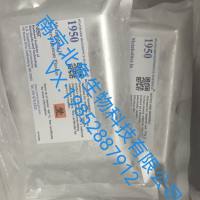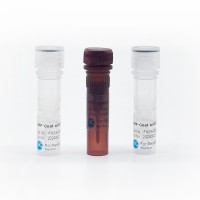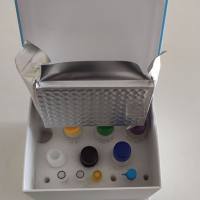Method: Lymphoblastoid Cell Lines from Frozen Whole Blood
互联网
Method: Lymphoblastoid Cell Lines from Frozen Whole Blood
May 31, 1990Rosalie Veile
Purpose:
-
Blood Samples can be stored frozen as a backup in case an LCL is needed at a later date.
Time required:
-
15 minutes to freeze 1-4 cryotubes placing them directly into the -135 degrees C freezer; orone hour to freeze the tubes using the Cryomed freezing chamber. Cells have been shown to be more viable if temperature is lowered gradually with the freezing chamber.
Procedure:
Thawing cells for transformation:
-
Freezing cells:
-
-
Pipette 1.0 ml of whole blood into 2 cryotubes (1.25ml).
-
Add to each cryotube 100 µl dimethyl sulfoxide (DMSO), or 10% of the volume of blood.
-
Immediately begin freezing the whole blood in the cryomed freezing chamber until the chart drive printer reads -90 degrees C.
- Quickly transfer the frozen sample to long term storage in a -135 degrees C freezer or a liquid nitrogen storage container. These whole blood samples have been shown to be viable for as long as 5 months by G. Chenevix-Trench, et al.
-
When an LCL is needed, the cells are thawed rapidly in a 37 degrees C water bath: Place the cryotubes in a bubble rack. Shake the rack to help thaw the cells, usually for 1-2 minutes.
-
With a 1 ml disposable pipet, transfer the sample to a 15 ml conical centrifuge tube filled with 10 ml of wash media.
-
Centrifuge the cells for 10 minutes at 1200 rpm, no brake, at room temperature.
-
Aspirate the wash media to just above the cell pellet. Wash the pellet again with 10 ml wash media and centrifuge as in step 7. Repeat the wash a total of 4 times or until the red cell contamination is minimal. If the red cell contamination is not eliminated, several days in culture will decrease the amount of red cells substantially.
-
Aspirate the wash media and resuspend the cell pellet in 300 µl filtered supernatant from a B95-8 marmoset culture containing Epstein Barr virus. Transfer the cell suspension to a T-25cm2 flask and incubate for 2 hours at 37 degrees C with 5% CO2. If there is a very small volume of cells, leave the cells in the 15 ml centrifuge tube for the incubation.
-
After incubation, add 800 µl RPMI-1640 containing 20% fetal bovine serum and 2X Cyclosporin A.
-
Using a 5 ml disposable pipet, plate out cells in serial dilution in a 96-well microtiter plate: Transfer half of the cells in the first well into a second well. Add enough media to fill the second well. Then take half of this cell/media mixture and transfer to a third well. Fill up the third well with media. Incubate at 37 degrees C with 5% CO2.
-
Feed the cells twice-weekly by removing half of the old media and replacing with fresh media until transformed colonies are apparent (ususally 2-3 weeks). The new media should contain 1X CSA.
- Subculture cells to a 24-well plate before transferring to culture flasks. Maintain the subcultures on growth media (no CSA).
-
Pipette 1.0 ml of whole blood into 2 cryotubes (1.25ml).
Solutions:
-
Growth media: (600 ml)
To 500 ml of sterile RPMI 1640 with 2 mM L-glutamine, add: 90.0 ml FBS 6.0 ml 200 mM (100X) L-glutamine 0.6 ml 50 mg/ml gentamicin reagent Note: Filter sterilize through a 0.22 µm filter and store up to 2 weeks at 4 degrees C.
-
Wash media: (1 liter)
To 1 liter of sterile RPMI 1640 with 2 mM L-glutamine, add: 10.0 ml 2.5 M (100X) hepes buffer 1.2 ml 50 mg/ml gentamicin reagent Note: Filter sterilize through a 0.22 µm filter and store up to 2 weeks at 4 degrees C.
-
2X Cyclosporin A media: (1 µg/ml)
To 100 ml of growth media add 2 ml of 100X Cyclosporin A.
-
100X Cyclosporin A: (100 ml)
Dissolve 1 mg CSA in 0.1 ml ethanol, add 0.02 ml Tween 80 and mix well. While continually stirring, add 1 ml RPMI, drop by drop. Quanitate to a final volume of 100 ml with RPMI. Filter sterilize and store at 4 degrees C for up to 4 months.
References:
Chenevix-Trench, G., et al, Am. J. Hum. Genet. 46:635-636, 1990.









